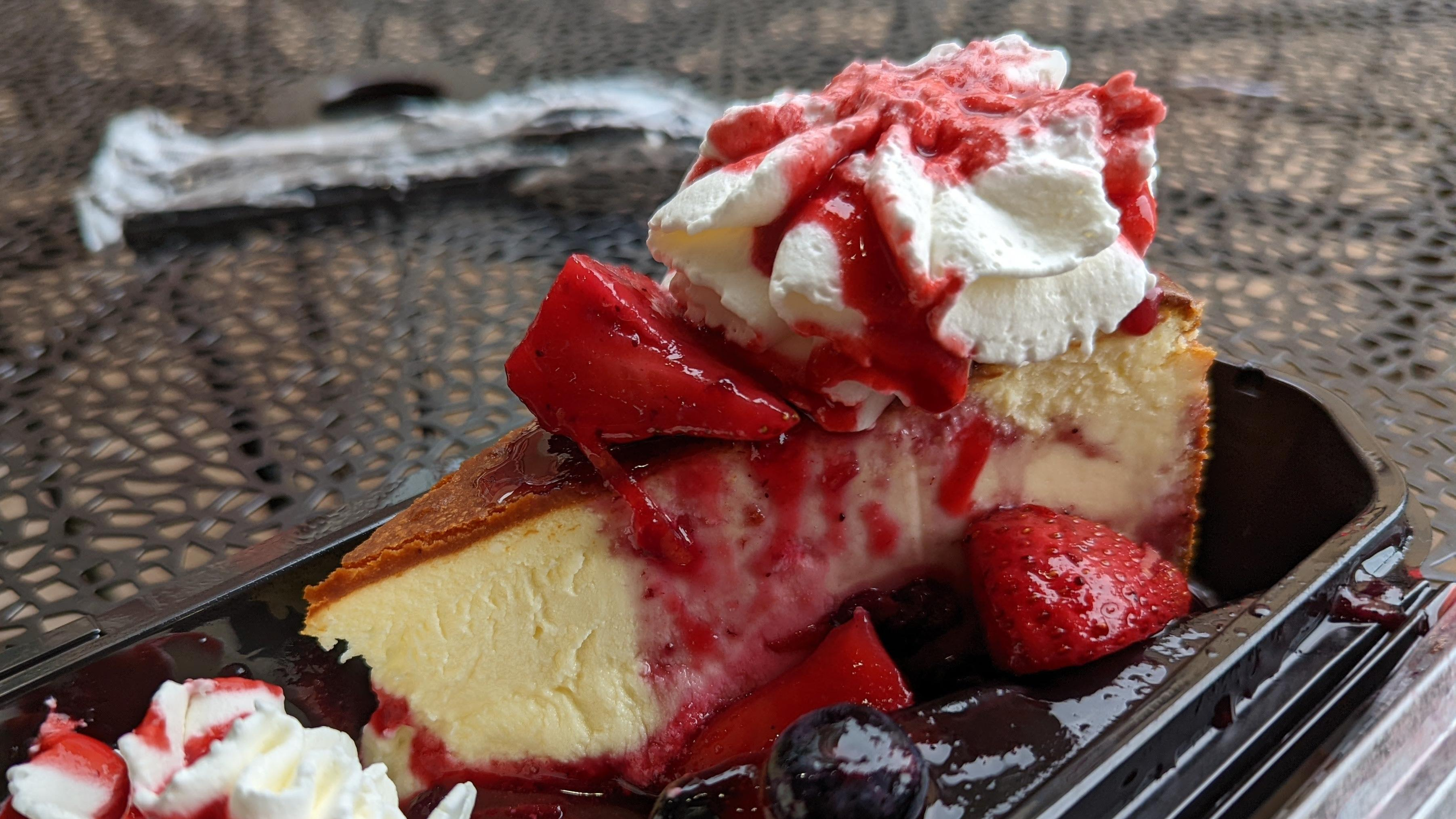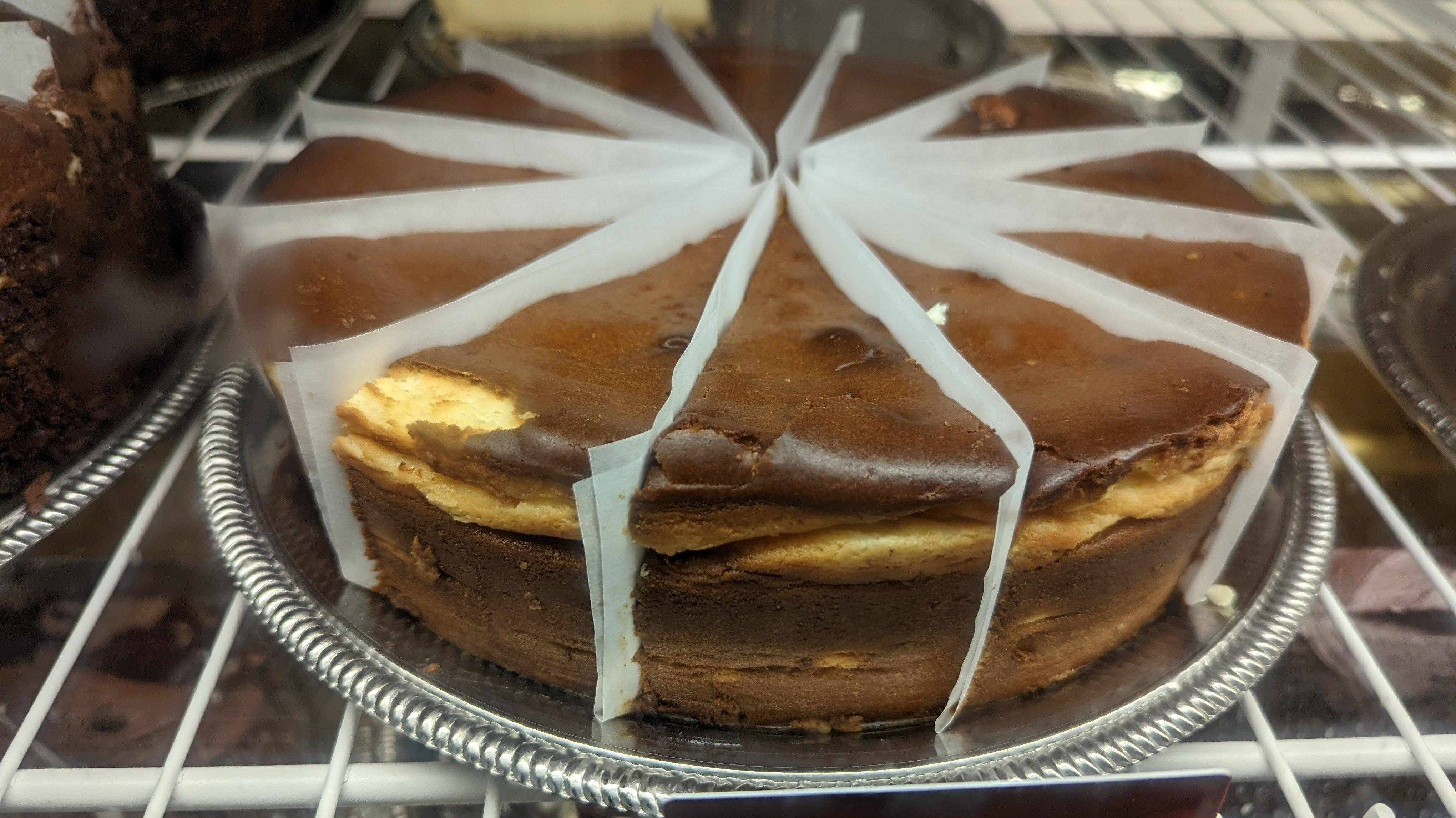Basque In The Imperfection Of The Cheesecake Factory's Newest Dessert
The Classic Basque Cheesecake is a bit of a mess, presumably on purpose.
There's a visceral satisfaction in the smooth planes of a perfectly executed cheesecake, particularly the dense New York style. From the side, an elegantly seamless curve where the entire round was gently released from a Springform pan, you can see the thinly layered base of pressed graham crackers—a delicate stage for a luxurious filling. A flawless execution has a consistent texture throughout, a body firm enough to imprint a trail as the tines of your fork slide down the wedge, remaining solid, unblemished, untouched.
The destruction of perfection, a release of tension, like running into winter's first snow. Ahhh.
It's this seamless aesthetic that's at the core of The Cheesecake Factory's success. No matter which of the restaurant's wild cheesecake variations you choose across all 308 North American and international locations, you can reliably count on uniform, virginal perfection.
That is, until now, with the introduction of the Classic Basque Cheesecake.
Launched July 30 on National Cheesecake Day, this latest addition to the already enormous menu takes an abrupt departure from the chain's hit formula of formulaic, attempting instead to master the Basque style, a trending dessert that can best be described as chaos in cheesecake form.
What is burnt Basque cheesecake?
It sounds like a new-old discovery, doesn't it? Like, "from the annals of Spanish culinary history, this traditional regional dessert has risen to newfound glory," blah, blah, blah—all the reverent rhetoric of "found" cuisine.
When I started seeing pictures of Basque cheesecake on Goldbelly during the pandemic, before it was named the 2021 "taste of the year" by the New York Times, I was at first confounded. As a native New Yorker, I had a very set idea in my head of what constituted cheesecake excellence, and this dark, misshapen confection was not it. But then I read the name, with all its implied authenticity and regional exclusivity, and assumed it must be historic and important. I mean, it even looks old, all wrinkly and blistered, slumped over in defeat.
Wow, did I feel like a sucker when I learned that it's younger than I am.
This now-viral take on cheesecake was only born in 1990, in the kitchen of La Viña restaurant in San Sebastian, Spain. Legend has it that it was one of the many results of a self-imposed cake-a-day experiment undertaken by Chef Santiago Rivera for who knows how long. (Certainly not the internet—I asked it.)
In its most original form, it's a simple five-ingredient crustless cheesecake baked at a high temperature in parchment paper. Sounds simple, right? But the devil's in the details, because the OG is known for more than its dejected appearance.
I mean, obviously, that's important. It ought to be dark, mottled, and slightly concave in the middle, with noticeably higher sides that ripple with brown spots thanks to the parchment paper. Cracks, the bane of any New York–style cheesecake maker, are not only acceptable in a Basque cheesecake, but encouraged.
Yet within that scorched-looking exterior should lie three layers of texture, the most important one being a slightly runny, custardy center, loosely encased by increasing levels of firmness the closer you get to the signature "crust." The crust itself needs to be burnt enough to impart a caramelized nuttiness (hi, Maillard reaction), but not so actually burnt that it tastes overly bitter. And some people add salt or more assertive cheeses like gorgonzola to tweak the flavor profile. So even though it's been called the cheesecake you can't mess up, it can still fall short of ideal.
But according to the internet, when it's great, it's awesome. And of course, the biggest name in mass-produced cheesecake had to hop on board to defend the crown.
"We had been working on a Basque cheesecake for quite some time," said Chris Radovan, Executive Pastry Chef & VP of Bakery Research & Development for The Cheesecake Factory Incorporated. "I'd always been a huge fan of the flavor and texture of an oven-baked cheesecake—there's something wonderful about the caramelization notes and the dryness, particularly in the heel of the cake."
"I started playing around with an overbaked cheesecake a few years ago without knowing about burnt Basque cheesecake," Radovan explained. "After doing some research, I discovered [it], and it was very much what I had in mind!" As he started "seeing [them] appear on many upscale restaurants' menus," it became clear that mastering this style was a challenge The Cheesecake Factory had to rise to.
So, how did The Cheesecake Factory do?
In a nut-brown shell, pretty damn good.
Because the wait for a table was unreasonably long, I got my slice to go. And because I don't trust myself not to inhale a 1,150-calorie slice of cheesecake like the scuttling trash panda I am, I had a friend assist in the tasting, which we did on a sunstorm-wet patio table in an Atlanta mall courtyard.
Whole and in the case, the Basque cheesecake was immediately prettier than the ones we'd seen online: much more even-looking across the top, with few cracks and bubbles, it was a uniform shade of light leather brown. This outer layer was clearly thin and crackle-able, and the entire cake was a level height, which was not the case with any of the famous renditions slung on Goldbelly.
Also unlike other images I'd seen of burnt Basque cheesecakes, it also came dressed up, topped with swirls of whipped cream and seemingly macerated berries (despite copy that repeats "fresh"), the latter in lesser quantity than the vanity shots and in a super-sweet syrup that was thin without being watery.
But that's not the texture we're interested in. In addition to "the wonderful flavor that comes from the caramelization on the outside of the cake," Radovan's goal was to "achieve the three distinct textures Basque cheesecakes are known for."
The slice hit two of them inarguably well and one debatably so.
The edges are certainly on the drier side, and slightly crumbly—something in between the heel of a loaf of bread and Italian ricotta cheesecake. The whipped cream was a nice way to add moisture back in, while a buttery, sweetly nutty taste still managed to come through from underneath it. This added another dimension to the flavor profile of the rest of the slice, which was generally less sugar-laden and less tangy than the Cheesecake Factory's signature recipe.
The next level of texture traded crumbliness for a little bit of a graininess floating in silken, fluffy suspension, making each bite noticeably less consistent than a New York cheesecake. Custard with a light bite became the more dominant flavor. However, while the center wasn't a firm set, it wasn't the runny one touted by others, either. Its middle lay somewhere in the middle, as it were, making it hard to tell where the plentiful whipped cream ended and cheesecake began once I mashed it in my mouth.
Overall, it was very light and airy without being bouncy like a Japanese cheesecake. Even though I was expecting it to be more gelatinous, I wasn't mad at it. On the other hand, I can't say the same about the berry sauce, which started to infuse the cake, muddying its more subtle aspects.
"A perfect summer cheesecake; a crowd pleaser," my friend said in sticky approval. I said nothing; I merely continued to lift forkfuls of cheesecake to my face, despite my increasing sugar-induced thirst and random encounters with inexplicable coconut shreds.
Food is a reflection of our lives, and The Cheesecake Factory's foray into fancy, Internet-famous burnt Basque cheesecake says a lot about where we are today.
"Ugly delicious" is a concept we now wholeheartedly embrace, and as a result, Barbie cheesecake has gone Basque. As we the consuming public have let go of some of the strict boundaries of perfectionism, so has The Cheesecake Factory. While the brand still holds onto some of the angular precision that made its menu famous, it aims to become a little more human and a little less "factory" with this new entrant.
High-end food is getting more accessible, too, as we regular folks seek out simple pleasures in an effort to find joy as we get by in tough times. This $8.95 slice is a decent approximation of the Basque cheesecakes you'd normally have to shell out $79 for (plus shipping), and it's a great little gateway to The Finer Things Club—the California roll of haute dessert.

